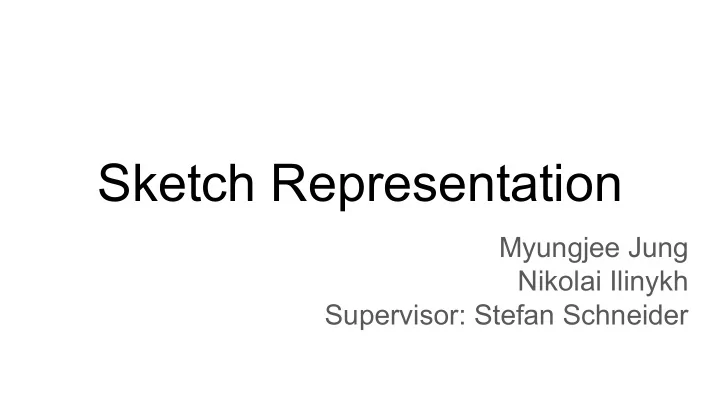

Sketch Representation Myungjee Jung Nikolai Ilinykh Supervisor: Stefan Schneider
Overview 1. Introduction 2. Experiment a. RCC8 b. Methods c. Analysis 3. Conclusion
If someone is looking at the sketch, is the sketch represented directly into their mind?
Or is it connected to their mental 3D model of the object?
If we find out the general way to build 3D representation based on sketch representation, we can build some system to describe them.
Our study was based on RCC8 RCC8
We made some cheat sheet to the participants, which is TPP RCC8 and TPPi, NTPP and NTPPi is combined as one relation, because we can simply name the part.
Methods 9 Participants(6 male, 3 female) Smart pen 5 objects(owl, apple tree, alarm clock, tea pot, bicycle) Describing parts, describing spatial relations based on RCC8, drawing the given objects
Participants describe parts, relations, and they move on to the drawing. After they drew the object, they were asked if there is any description that they want to change.
Analysis of the experiment What were the questions we asked ourselves? - similarities, differencies, frequency of mentioning this or that part of the object; - 2D or 3D representation; - validity of equality relations; - which relations are the most useful ones; - is there any confusion about the use of particular relations?
Apple Tree
Tea Pot
Alarm Clock
Owl
Bicycle
Obversations Most widely used relations: 1. PO (partially overlapping); 2. EC (externally connected); 3. DC (disconnected); 4. PP / TPP (proper part / tangential proper part). Almost no EQ (equality) relations → the use of EQ makes no sense. We checked which relations are used by most of the participants. People have used these 4 relations in most of the proposed cases. We guess that exactly these relations might build the crucial point in making a new spatial representation language.
2D vs 3D - PP / TPP confusion? The confusion here is that people write representations thinking about models in 3D way while they draw them in 2D way (for example, there is PP connection between case and the battery, though there is no battery on the picture, only case is present. This is one of our first observations: people think about things differently when they draw sketches and when they describe things. Maybe changing the order of presenting might also somhow influence the situation?
Extension of EC EC might be extended and broadened by adding more relations which differentiate various positions and parts of a subject. For example, cover and handle are both EC to the pot, but cover is not a proper part of the pot as handle: should we divide EC somehow to capture this difference?
Live beings confusion TPP Belly - feathers, participant 4: TPP feathers - wings, head, PO body - wings, TPP feathers - legs, PO body - head EC feathers - ears PO head - eyes - why EC for the last case? PP body - organs - why not TPP or PP for the first three? Looks like people might think in both 2D and 3D ways sometimes! 2D proof: ‘head’ and ‘body’ or ‘head’ and ‘eyes’ in the second example are PO in 2D dimension and participants see it exactly this way, because in 3D it would be rather PP than PO but participants didn’t mention this. 3D proof: at the same time ‘body’ and ‘organs’ in the second example are PP in 3D dimension and participants see it exactly this way; in the first example ‘feathers’ and ‘ears’ are mentiones as EC just like in 2D (in 3D it would be rather TPP just like the other relations in this example)
RCC8? Our results regarding the use of RCC8: - PP relations are not necessarily captured (should they? depends on how people represent things: 2D or 3D, we need to elaborate more on that) - ‘tea’ and ‘pot’ are TPP, but ‘digits’ and ‘case’ are TPP too - we need some inclusive relation (IP - inclusive part, for ‘tea’ or any liquid-like things) - EC and DC raise no problems in use - we would rather accept them to be parts of our language.
Future research In order to support our observations and ideas or overthrown them, more experiments should be conducted. Modifications of the experiment: - 2D / 3D - changing the order (picture first, description second) - let people freely describe relations without language restrictions
Thank you for your attention! Have a nice time in Osnabrück =)
Recommend
More recommend